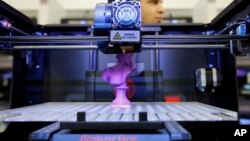It is amazing to think that printing of three-dimensional objects, now commonly referred to as 3-D printing, was invented only a little more than 30 years ago. Once bulky, complicated, and enormously expensive, 3-D printers have since shrunk into devices no larger than a microwave oven and can be bought in a store or online for as little as $500.
Experts say that rapid technological improvement of these machines, together with affordability, will have huge impact on manufacturing and service industries as well as on our private lives.
The automobile industry is already printing plastic parts for its vehicles, while the U.S. Department of Energy, together with Oak Ridge National Laboratory, recently printed a life-size plastic replica of a classic American roadster, the Shelby Cobra.
The man behind that project, Robert Ivester, deputy director of DOE’s Advanced Manufacturing Office, admits that polymer plastic printing is attracting a lot of attention, but he says 3-D printing with metals presents a more profound level of technical innovation.
In his office in the huge James Forrestal Building, in downtown Washington, D.C., Ivester demonstrated a complex metal part called a circular hot gas diffuser.
“What’s special about this is that it’s a 3-D-printed example,” he explained. “There are internal passage geometries that they can achieve in a much more straightforward way when it comes to production. So, this is a more straightforward and far less expensive way of manufacturing common parts.”
Reliable and durable
In metal 3-D printing, powdered metals are consolidated layer upon layer by heating them with a laser or electron beam.
There have been concerns about mechanical durability of parts made of layers, but Ivester says that problem has been resolved.
“It’s certainly possible with the latest technology to print metal components that are comparable and in some cases superior to the mechanical performance of conventionally produced parts.”
Showing off a small sample made of smoothly finished metal, he said, “If you look very carefully at it, you can see that the letters DOE are visible in the structure. The reason for that is that inside the block letters, that D, O and E, there’s one type of a crystalline structure and surrounding them is a different type.”
Ivester points out that this is still an early stage of research into metal 3-D printing, but says he is confident that very soon it will be transferred to industry.
The advantages are enormous. What now takes weeks or months to manufacture in conventional way, in a metal 3-D printer may take only hours, which brings down the cost, especially if you only need a small number of parts, or a highly specialized component of a machine.
The other advantage concerns geometry of printed parts.
“We can achieve internal part complexities that were either impossible or very difficult to produce through other means,” Ivester said.
3D future
So, where is metal 3-D printing going to be in the next 10, 20, 30 years? Ivester says he expects simultaneous reduction of printer cost and expansion of printer capabilities. They will become faster, with higher resolution and smoother finish.
He predicts we will soon be able to simply scan a complicated part in a 3-D scanner and print it within hours rather than weeks or months.
“That,” he pointed out, “on a much broader scale, in hands of everybody, has a potential to really transform how we operate as a society and in terms of how we make things, and opens the door to people making things for themselves in a way that has never been there before.”
And this, he adds, will open doors to creativity as never before. The ideas that really work will bubble up and propagate, accelerating the pace of innovation.






